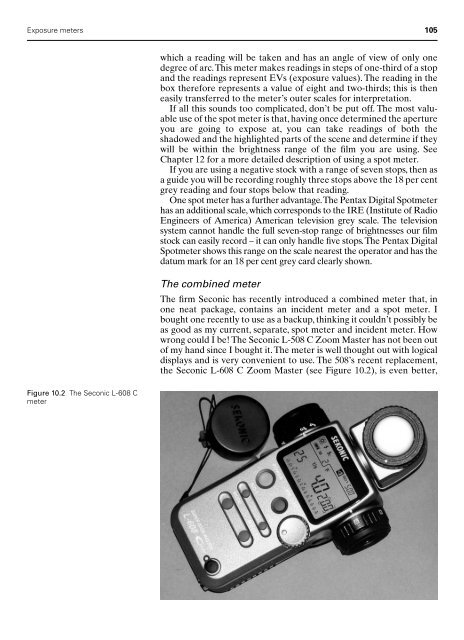1 The Director of Photography – an overview
1 The Director of Photography – an overview
1 The Director of Photography – an overview
You also want an ePaper? Increase the reach of your titles
YUMPU automatically turns print PDFs into web optimized ePapers that Google loves.
Exposure meters 105<br />
Figure 10.2 <strong>The</strong> Seconic L-608 C<br />
meter<br />
which a reading will be taken <strong>an</strong>d has <strong>an</strong> <strong>an</strong>gle <strong>of</strong> view <strong>of</strong> only one<br />
degree <strong>of</strong> arc.This meter makes readings in steps <strong>of</strong> one-third <strong>of</strong> a stop<br />
<strong>an</strong>d the readings represent EVs (exposure values). <strong>The</strong> reading in the<br />
box therefore represents a value <strong>of</strong> eight <strong>an</strong>d two-thirds; this is then<br />
easily tr<strong>an</strong>sferred to the meter’s outer scales for interpretation.<br />
If all this sounds too complicated, don’t be put <strong>of</strong>f. <strong>The</strong> most valuable<br />
use <strong>of</strong> the spot meter is that, having once determined the aperture<br />
you are going to expose at, you c<strong>an</strong> take readings <strong>of</strong> both the<br />
shadowed <strong>an</strong>d the highlighted parts <strong>of</strong> the scene <strong>an</strong>d determine if they<br />
will be within the brightness r<strong>an</strong>ge <strong>of</strong> the film you are using. See<br />
Chapter 12 for a more detailed description <strong>of</strong> using a spot meter.<br />
If you are using a negative stock with a r<strong>an</strong>ge <strong>of</strong> seven stops, then as<br />
a guide you will be recording roughly three stops above the 18 per cent<br />
grey reading <strong>an</strong>d four stops below that reading.<br />
One spot meter has a further adv<strong>an</strong>tage.<strong>The</strong> Pentax Digital Spotmeter<br />
has <strong>an</strong> additional scale, which corresponds to the IRE (Institute <strong>of</strong> Radio<br />
Engineers <strong>of</strong> America) Americ<strong>an</strong> television grey scale. <strong>The</strong> television<br />
system c<strong>an</strong>not h<strong>an</strong>dle the full seven-stop r<strong>an</strong>ge <strong>of</strong> brightnesses our film<br />
stock c<strong>an</strong> easily record <strong>–</strong> it c<strong>an</strong> only h<strong>an</strong>dle five stops.<strong>The</strong> Pentax Digital<br />
Spotmeter shows this r<strong>an</strong>ge on the scale nearest the operator <strong>an</strong>d has the<br />
datum mark for <strong>an</strong> 18 per cent grey card clearly shown.<br />
<strong>The</strong> combined meter<br />
<strong>The</strong> firm Seconic has recently introduced a combined meter that, in<br />
one neat package, contains <strong>an</strong> incident meter <strong>an</strong>d a spot meter. I<br />
bought one recently to use as a backup, thinking it couldn’t possibly be<br />
as good as my current, separate, spot meter <strong>an</strong>d incident meter. How<br />
wrong could I be! <strong>The</strong> Seconic L-508 C Zoom Master has not been out<br />
<strong>of</strong> my h<strong>an</strong>d since I bought it.<strong>The</strong> meter is well thought out with logical<br />
displays <strong>an</strong>d is very convenient to use. <strong>The</strong> 508’s recent replacement,<br />
the Seconic L-608 C Zoom Master (see Figure 10.2), is even better,

















